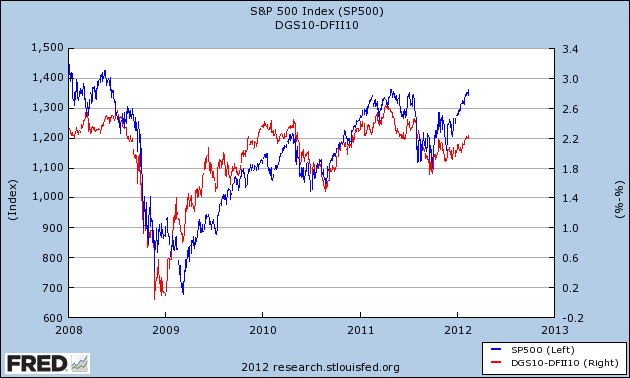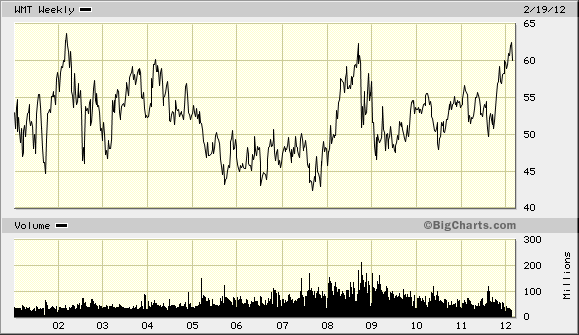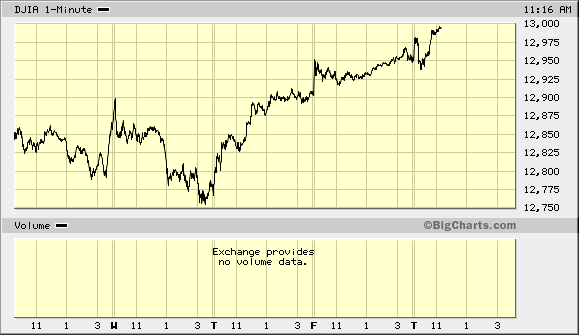Archive for February, 2012
-
Does the Stock Market Love Inflation?
Eddy Elfenbein, February 22nd, 2012 at 10:13 amIt appears so. Here’s a graph of the S&P 500 versus the 10-year inflation premium (the 10-year T-bond yield minus the 10-year TIPs yield). Since 2008, these two series have been waltzing partners.
There’s no reason to expect a long-term relationship to last. After all, we’re comparing a price index to a yield. But, for whatever reason, whatever causes investors to expect more inflation seems to be highly aligned with higher equity prices. Correlation, of course, doesn’t mean causation.
-
Obama Wants 28% Corporate Tax Rate
Eddy Elfenbein, February 22nd, 2012 at 9:20 amPresident Barack Obama is proposing to cut the corporate tax rate from 35 percent to 28 percent and wants an even lower effective rate for manufacturers, a senior administration official says, as the White House lays down an election-year marker in the debate over tax policy.
In turn, corporations would have to give up dozens of loopholes and subsidies that they now enjoy. Corporations with overseas operations would also face a minimum tax on their foreign earnings.
Over the last 40 years, corporate taxes have fallen as a percentage of federal revenues. I can’t say if this has a realistic chance of becoming law. I would think that fighting for corporations during an election isn’t a good idea.
Of course, corporations don’t pay taxes. A corporation is just a piece of paper. The companies pass the cost on to their customers. The benefit for the government is that it hides their taxes by imbedding it in a third-party’s prices.
-
Walmart’s Trading Range Lives
Eddy Elfenbein, February 22nd, 2012 at 9:08 amA few weeks ago, I noted that Walmart ($WMT) has been trapped in the “Mother of All Trading Ranges” for the last 12 years. Not once in over 3,000 trading days has WMT closed above $64 or below $42. The last time it did was on January 19, 2000 when it closed at $64.06. More than 78% of the time, the stock been between $48 and $59.99.
On Friday, the stock closed at $62.48 which is very close to the top of its range. It seemed like the strange range would finally be broken. But yesterday, Walmart’s disappointing earnings knocked the shares back to $60.07.
By the way, Walmart’s sales rose by 5.8% to $122.29 billion. That means that Walmart averaged $1 million in sales. A minute. Also, despite what people may think of how corporations are run, Walmart’s profit margin was just 4.24%.
-
Bloomberg: Stocks Cheapest in 50 Years
Eddy Elfenbein, February 22nd, 2012 at 8:09 amAccording to an article at Bloomberg, U.S. stocks are near the cheapest level relative to bonds in 50 years. Here’s how it works: If we take the market’s price/earnings ratio and flip it over to get earnings divided by price, then we have the earnings yield. When we compare that yield to the yield on the 10-year Treasury bond, the gap in favor of stocks is close to the widest its been since 1962.
Earnings in the S&P 500 have more than doubled to $96.58 since 2009 and are projected to reach a record $104.28 this year, more than 11,000 analyst estimates compiled by Bloomberg show. The earnings yield, or annual profits divided by price, climbed to 7.1 percent, 5 percentage points more than the rate on 10-year Treasuries. That’s wider than in 97 percent of months in 50 years of Bloomberg data.
I think this analysis is basically sound; however, there are a few problems. It says that stocks are cheap versus bonds. It doesn’t mean that stocks are cheap on an absolute level. In other words, it can mean that bonds are over-priced which I think is also true.
On a philosophical level, we should remember that all prices are relative. We’ve been trained to think that all prices are expressed in dollars, but that’s a bit of a mind trick. All prices are relative to each other — dollar bills are just the middleman.
Ideally, the earnings yield ought to be compared with rates longer than the 10-year bond. What’s interesting is that rates are unusually steep after ten years. The 20-year yield is currently 79 basis points over the 10-year, while the 30-year is 115 basis points above it.
The spread was last this wide in the four months before the S&P 500 (SPX) reached a 12-year low in March 2009, data compiled by Bloomberg show. The benchmark gauge for American equities has increased 101 percent since then, including an 8.3 percent increase in 2012, the best start to a year since 1997.
Low valuations and signs of recovery have failed to lure individuals back to equities. Stocks are trading at a 14 percent discount to their average price-earnings ratio over the past five decades. The multiple has been stuck below the mean of 16.4 times earnings since May 2010, the longest stretch below the average since the 13 years beginning in 1973, data compiled by Bloomberg show.
(…)
Capital investments surged in 2006 as the total debt-to- assets ratio in the S&P 500 was climbing to 38.8 in the third quarter of 2007, the highest point since at least 1998, data compiled by Bloomberg show. The ratio is about 32 percent lower now. Companies spent the past three years paying down debt and cutting costs, boosting the S&P 500 profit margin to 13.8 percent, compared with 8.3 percent in 2009, the data show.
S&P 500 companies increased cash and equivalents for 12 straight quarters to $998.6 billion in the third quarter, 60 percent more than in September 2007, just before the index reached an all-time high of 1,565.15, according to S&P. The total excludes financial, utility and transportation companies.
I caution investors that while this analysis is very useful, don’t get too caught up in models. All this is based on projections. Outside of a few months, forecasters don’t really have a good idea of what’s going to happen. They’re usually good at predicting that an existant trend will continue. But they’re not so good at spotting the turning points which is the most important part.
-
Morning News: February 22, 2012
Eddy Elfenbein, February 22nd, 2012 at 5:49 amGreek Bailout Wins Two Cheers From Wary Investors
Greek Crisis Raises New Fears Over Credit-Default Swaps
New Bailout Is a Reprieve for Greece, but Doubts Persist
A Battle for Mongolia’s Copper Lode
Oil Trades Near 9-Month High After Iran Denies Access to UN Team
Obama Offers to Cut Corporate Tax Rate to 28%
Watchdog Targets Overdraft Charges
High-End Retailers Report Strong Profits, but Walmart Still Struggles
Dell Earnings and Forecast Fall Short of Wall St. Views
Kraft’s Net Rises 54% on Higher Prices
Alibaba Offers to Take Web Portal Unit Private
Ford Pours $3.8 Billion into Pension Plan, Eyes Shift to Bonds
Peugeot in Alliance Talks After Report of GM Discussions
Shell Offers to Buy Cove Energy for $1.6 Billion
Paul Kedrosky: The Unexpected Physical Consequences of Technology
Every Face Punch in Road House!
Be sure to follow me on Twitter.
-
After Market Updates
Eddy Elfenbein, February 21st, 2012 at 9:54 pmUltimately, the stock market gave back some of its gains this afternoon. The S&P 500 closed at 1,362.21 which was just shy of the post-crash high close of 1,363.61 from May 2nd of last year.
Today’s market was split between large-cap stocks which fared the best and small-cap stocks which fared the worst. The small-cap Russell 2000 was down 0.66% today while the S&P 500 was up 0.98 points or 0.07%. The mega-cap S&P 100 was up 0.27%.
Interestingly, shares of Apple ($AAPL) gained $12.73 or 2.54%. That’s a market cap gain of $11.87 billion. Each point in the S&P 500 is worth $9.05 billion. That means that Apple’s gain was worth 1.31 points in the S&P 500. The index gained 0.98 points so without Apple, the index would have closed just slightly lower today.
In Buy List news, Johnson & Johnson‘s ($JNJ) CEO resigned:
William C. Weldon, who presided over Johnson & Johnson during one of the most tumultuous periods in its history, will step down as chief executive in April, the company announced Tuesday.
Alex Gorsky, head of the medical device and diagnostics business, will take over as chief executive. Mr. Weldon will remain as chairman.
The news of Mr. Weldon’s retirement comes as Johnson & Johnson has struggled to emerge from a swarm of product recalls, manufacturing lapses and government inquiries that tarnished the name of a company that was once one of the nation’s most trusted household brands. In 2010, the company recalled millions of bottles of liquid children’s Tylenol and other medications, as well as tens of thousands of artificial hips and millions of contact lenses.
Much of the blame for Johnson & Johnson’s stumbles fell on Mr. Weldon, the son of a Broadway stagehand and seamstress who became chief executive in 2002 after spending his entire career at the company. Critics said the company’s once-vaunted attention to quality slipped under his watch. The company said in a statement that neither Mr. Weldon nor Mr. Gorsky was available for comment.
Oracle ($ORCL) was downgraded by JMP Securities. They’re paring back their earnings estimates but they add that the stock is not unreasonably valued.
WSJ‘s “Market Beat” notes that DirecTV ($DTV) may soon join the streaming bandwagon.
-
Here Comes Dow 13,000
Eddy Elfenbein, February 21st, 2012 at 11:16 amThe stock market is up this morning and the Dow Jones Industrial Average is a mere 10 points from cracking 13,000.
I hope this will be different from the eight previous times we’ve broken 13,000. (That’s not an exaggeration. From April 2007 to May 2008, the Dow broke through 13,000 on eight different occasions going by the daily close.) If the Dow had merely kept pace with inflation over the last 12 years, it would be at 13,837 today.
The S&P 500 is currently up to 1,366 which would be a post-crash high. Today could be the highest close since June 5, 2008. That was 44.5 months ago.
On Friday, the Wilshire 5000 Total Return Index, which is about the broadest index possible, closed at its highest level since October 2007. That index includes dividends. By my math, we need a jump of 0.89% to make an all-time high. The Wilshire 5,000 is up 0.33% so far today.
-
Morning News: February 21, 2012
Eddy Elfenbein, February 21st, 2012 at 6:18 amGreece Wins Second Bailout as Europe Picks Aid Over Default
Draghi Stays Silent on ECB Role in Greek Bailout
Nordic Currencies Stung in Debt Crisis
U.S. in Accord With Mexico on Drilling
Foreign Investors Fear Japan Banks May Hijack Olympus
China Buys Least Iran Crude in Five Months Amid Price Talks
Rising Gas Prices Give G.O.P. Issue to Attack Obama
Fed Housing Blueprint Lost in Din of Politics
Some Doubt a Settlement Will End Mortgage Ills
Mazda Mulling Raising 170 Billion Yen, Shares Take Beating
URS Agrees to Acquire Flint Energy Services for $1.25 Billion
Wal-Mart Raises Stake to 51% in China Online Retailer Yihaodian
Trademarks Take On New Importance in Internet Era
Pinterest Introduces “NOPIN” to Counter Copyright Concerns
Howard Lindzon: The Incredible Shrinking World…Make It Work for You!
Phil Pearlman: Brett Steenbarger Classics A Must Follow for Young Traders
Be sure to follow me on Twitter.
-
50 Years Ago Today
Eddy Elfenbein, February 20th, 2012 at 1:06 pm -
The Stock Market is Closed for Washington’s Birthday
Eddy Elfenbein, February 20th, 2012 at 11:11 amThe New York Stock Exchange is closed today in honor of George Washington’s birthday. That’s right — on the NYSE, it’s not President’s Day. My apologies to Millard Fillmore but here’s the explanation from the NYSE:
Washington’s Birthday was first declared a federal holiday by an 1879 act of Congress. The Monday Holiday Law, enacted in 1968, shifted the date of the commemoration of Washington’s Birthday from February 22 to the third Monday in February, but neither that law nor any subsequent law changed the name of the holiday from Washington’s Birthday to President’s Day. Although the third Monday in February has become popularly known as President’s Day, the NYSE’s designation of Washington’s Birthday as an Exchange holiday (Rule 51) follows the form of the federal holiday outlined above (section 6103(a) of title 5 of the United States Code).
- Tweets by @EddyElfenbein
-
-
Archives
- April 2024
- March 2024
- February 2024
- January 2024
- December 2023
- November 2023
- October 2023
- September 2023
- August 2023
- July 2023
- June 2023
- May 2023
- April 2023
- March 2023
- February 2023
- January 2023
- December 2022
- November 2022
- October 2022
- September 2022
- August 2022
- July 2022
- June 2022
- May 2022
- April 2022
- March 2022
- February 2022
- January 2022
- December 2021
- November 2021
- October 2021
- September 2021
- August 2021
- July 2021
- June 2021
- May 2021
- April 2021
- March 2021
- February 2021
- January 2021
- December 2020
- November 2020
- October 2020
- September 2020
- August 2020
- July 2020
- June 2020
- May 2020
- April 2020
- March 2020
- February 2020
- January 2020
- December 2019
- November 2019
- October 2019
- September 2019
- August 2019
- July 2019
- June 2019
- May 2019
- April 2019
- March 2019
- February 2019
- January 2019
- December 2018
- November 2018
- October 2018
- September 2018
- August 2018
- July 2018
- June 2018
- May 2018
- April 2018
- March 2018
- February 2018
- January 2018
- December 2017
- November 2017
- October 2017
- September 2017
- August 2017
- July 2017
- June 2017
- May 2017
- April 2017
- March 2017
- February 2017
- January 2017
- December 2016
- November 2016
- October 2016
- September 2016
- August 2016
- July 2016
- June 2016
- May 2016
- April 2016
- March 2016
- February 2016
- January 2016
- December 2015
- November 2015
- October 2015
- September 2015
- August 2015
- July 2015
- June 2015
- May 2015
- April 2015
- March 2015
- February 2015
- January 2015
- December 2014
- November 2014
- October 2014
- September 2014
- August 2014
- July 2014
- June 2014
- May 2014
- April 2014
- March 2014
- February 2014
- January 2014
- December 2013
- November 2013
- October 2013
- September 2013
- August 2013
- July 2013
- June 2013
- May 2013
- April 2013
- March 2013
- February 2013
- January 2013
- December 2012
- November 2012
- October 2012
- September 2012
- August 2012
- July 2012
- June 2012
- May 2012
- April 2012
- March 2012
- February 2012
- January 2012
- December 2011
- November 2011
- October 2011
- September 2011
- August 2011
- July 2011
- June 2011
- May 2011
- April 2011
- March 2011
- February 2011
- January 2011
- December 2010
- November 2010
- October 2010
- September 2010
- August 2010
- July 2010
- June 2010
- May 2010
- April 2010
- March 2010
- February 2010
- January 2010
- December 2009
- November 2009
- October 2009
- September 2009
- August 2009
- July 2009
- June 2009
- May 2009
- April 2009
- March 2009
- February 2009
- January 2009
- December 2008
- November 2008
- October 2008
- September 2008
- August 2008
- July 2008
- June 2008
- May 2008
- April 2008
- March 2008
- February 2008
- January 2008
- December 2007
- November 2007
- October 2007
- September 2007
- August 2007
- July 2007
- June 2007
- May 2007
- April 2007
- March 2007
- February 2007
- January 2007
- December 2006
- November 2006
- October 2006
- September 2006
- August 2006
- July 2006
- June 2006
- May 2006
- April 2006
- March 2006
- February 2006
- January 2006
- December 2005
- November 2005
- October 2005
- September 2005
- August 2005
- July 2005



 Eddy Elfenbein is a Washington, DC-based speaker, portfolio manager and editor of the blog Crossing Wall Street. His
Eddy Elfenbein is a Washington, DC-based speaker, portfolio manager and editor of the blog Crossing Wall Street. His